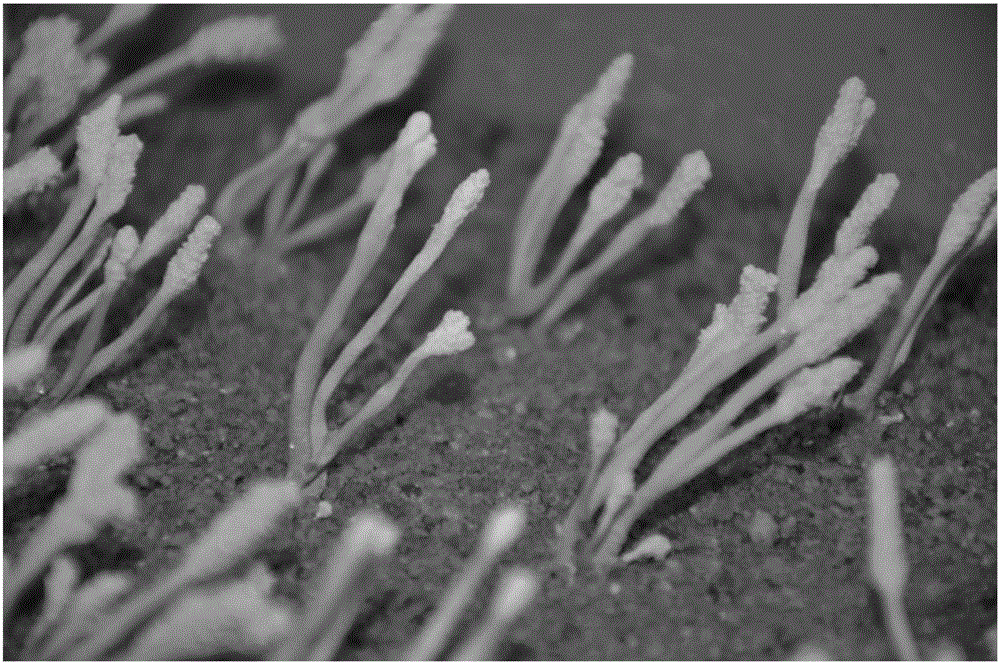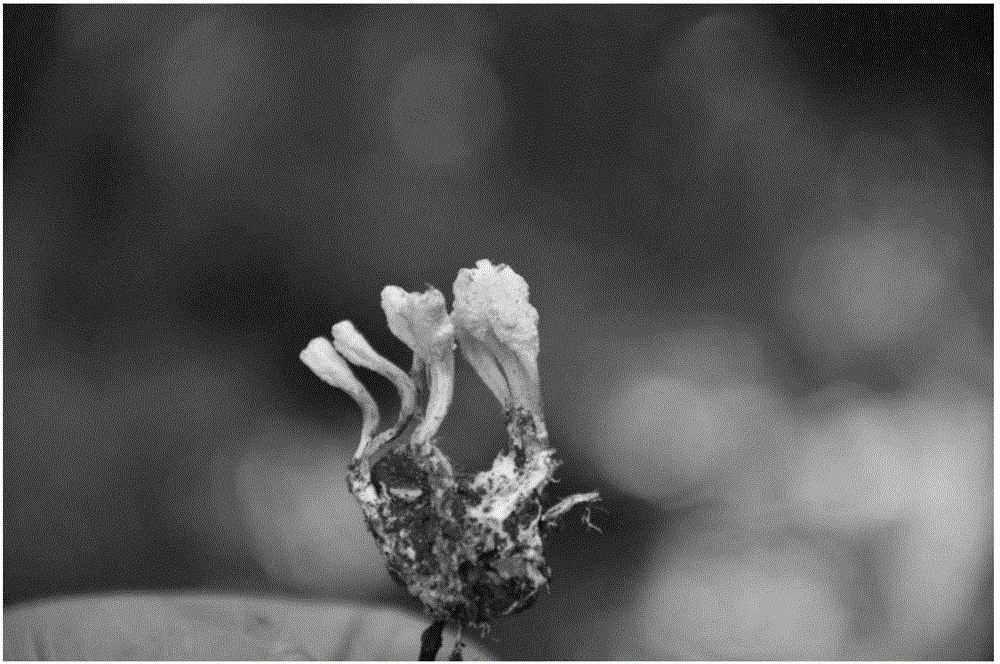Artificial silkworm chrysalis cordyceps sobolifera cultivation method achieved by taking tussah silkworm chrysalises as hosts
A technology of artificial cultivation and silkworm chrysalis, applied in botany equipment and methods, cultivation, plant cultivation, etc., can solve the problems of not using tussah silkworm chrysalis to cultivate cicadas, and achieve the effects of short cultivation period, safe and reliable food, and simple technical process
- Summary
- Abstract
- Description
- Claims
- Application Information
AI Technical Summary
Problems solved by technology
Method used
Image
Examples
Embodiment 1
[0027] 1. Isolate from wild cicada flowers collected in the bamboo forest of Anji, Zhejiang. After multiple generations of screening, a cicada flower strain capable of infecting tussah silkworm pupae is obtained, which is inoculated on a PDA solid medium and cultured in the dark at 20°C for 10 days to grow hyphae After incubation, alternate light and dark culture at 24°C, with a period of 14h, light intensity 350Lx, humidity 95%, and a culture time of 10d. After the spores are overgrown, wash the spores with 0.03% Tween 80 sterile water to make a spore suspension of cicada flower and dilute to a concentration of 10 4 Pieces / mL.
[0028] 2. Use 75% alcohol to disinfect the body surface of the tussah silkworm pupa by spraying. Use a micro syringe to inject 10ul of the cicada flower spore suspension into the tussah silkworm pupa subcutaneous tissue. After inoculation, quickly put it into a sterilized petri dish for infection. .
[0029] 3. Culture the infected tussah silkworm pupae i...
Embodiment 2
[0032] 1. Isolate from wild cicada flowers collected in the bamboo forest of Anji, Zhejiang. After multiple generations of screening, a cicada flower strain capable of infecting tussah silkworm pupae is obtained, which is inoculated on PDA solid medium and cultured in the dark at 21°C for 9 days until hyphae grow After incubation, alternate light and dark culture at 23°C, with a cycle of 12h, light intensity of 300Lx, humidity of 90%, and culture time of 11d. After the spores are overgrown, wash the spores with 0.05% Tween 80 sterile water to make a spore suspension of cicada flower and dilute to a concentration of 10 6 Pieces / mL.
[0033] 2. Use 75% alcohol to disinfect the body surface of tussah silkworm chrysalis by spraying, soak the silkworm chrysalis in a suspension of cicada flower spores for 10 minutes, then take it out, and put it into a sterilized petri dish for infection.
[0034] 3. Cultivate the infected tussah silkworm pupa in the dark in an incubator at 22°C until th...
Embodiment 3
[0037] 1. Isolate from wild cicada flowers collected in the bamboo forest of Anji, Zhejiang. After multiple generations of screening, a cicada flower strain capable of infecting tussah silkworm pupae was obtained. Inoculated on PDA solid medium, cultured in dark at 22°C for 8 days until hyphae were grown After incubation, alternate light-dark culture at 22°C, with a period of 12h, light intensity 250Lx, humidity 85%, and culture time 12d. After the spores are overgrown, wash the spores with 0.07% Tween 80 sterile water to make a spore suspension of cicada flower and dilute to a concentration of 10 5 Pieces / mL.
[0038] 2. Use 75% alcohol to disinfect the body surface of tussah silkworm pupa by spraying. Use a micro syringe to inject 15ul of cicada flower spore suspension into the subcutaneous tissue of tussah silkworm pupa. After inoculation, quickly put it into a sterilized petri dish for infection. .
[0039] 3. Culture the infected tussah silkworm pupa in the dark in a 25℃ incu...
PUM
 Login to View More
Login to View More Abstract
Description
Claims
Application Information
 Login to View More
Login to View More - R&D
- Intellectual Property
- Life Sciences
- Materials
- Tech Scout
- Unparalleled Data Quality
- Higher Quality Content
- 60% Fewer Hallucinations
Browse by: Latest US Patents, China's latest patents, Technical Efficacy Thesaurus, Application Domain, Technology Topic, Popular Technical Reports.
© 2025 PatSnap. All rights reserved.Legal|Privacy policy|Modern Slavery Act Transparency Statement|Sitemap|About US| Contact US: help@patsnap.com



